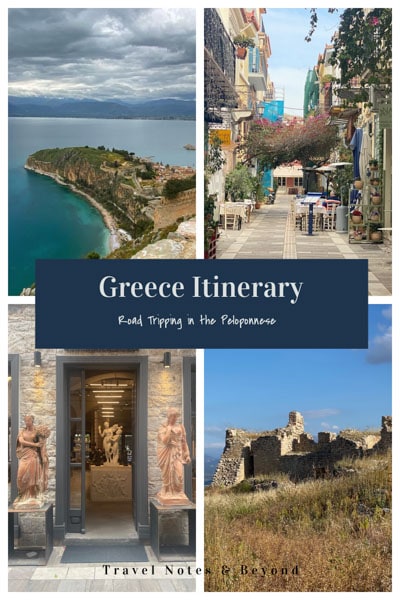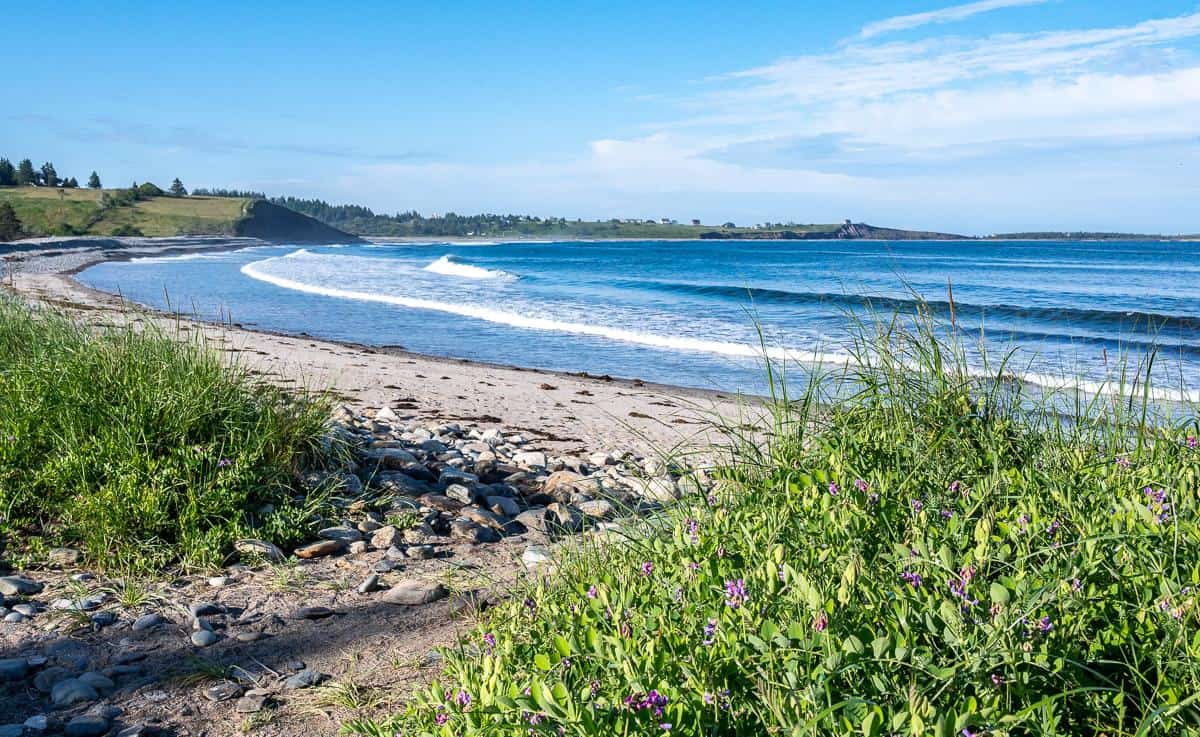Road Trip in the Peloponnese
19 min read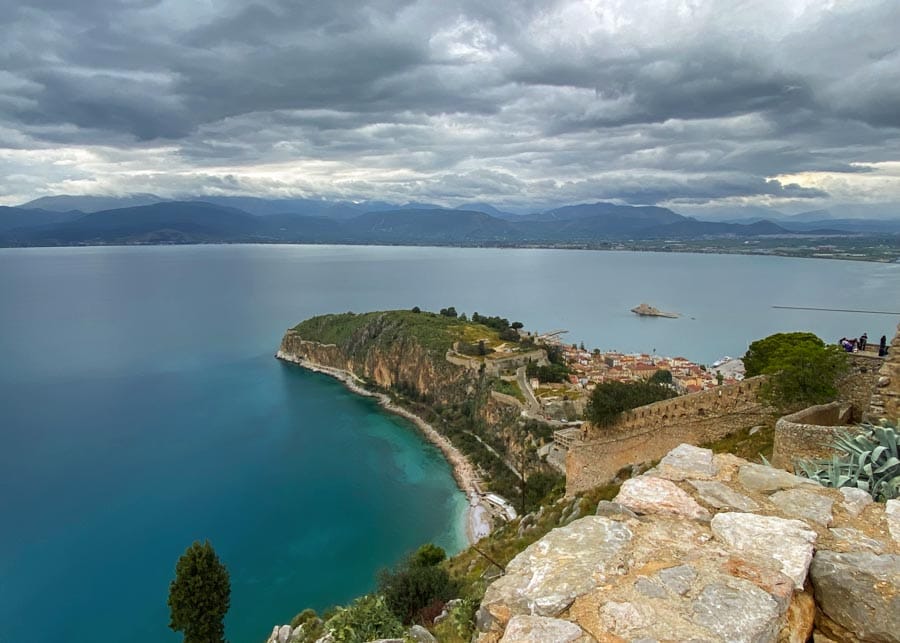
Table of Contents
Want to spend 2 weeks in Greece but can’t decide on an itinerary? We’ve been through that, so I can understand your dilemma. Greece is a country like no other: it’s large, diverse, and visually stunning. A captivating mixture of serene islands, soaring mountains, bustling cities, and impressive archeological sites. There are so many places to visit, but having too many options can sometimes be overwhelming. After many deliberations, we decided that a road trip in the Peloponnese would be the best choice for itinerary. And here is why:
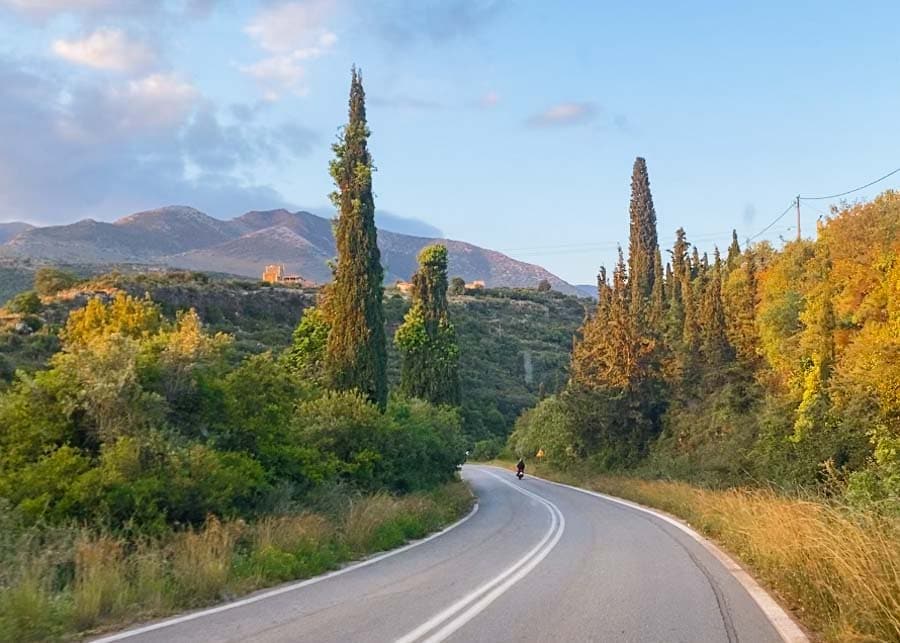
Why Choose a Peloponnese Itinerary for Your 2 Weeks in Greece
Peloponnese is the heart of the ancient Hellenic culture, home to a myriad of important archaeological sites that tell the story of Ancient Greece. Over the millennia many powerful states and empires inhabited this land, from the Spartans and the Romans, to the Franks, Venetians and the Ottomans. All these people left their legacies in the temples, castles, and the cities that you see today.
Where else can you walk in ancient agoras following the steps of great people like Socrates and Aristotle? Or stand on the rock from where the Apostle Paul first preached to the people of Athens about the one Creator God?
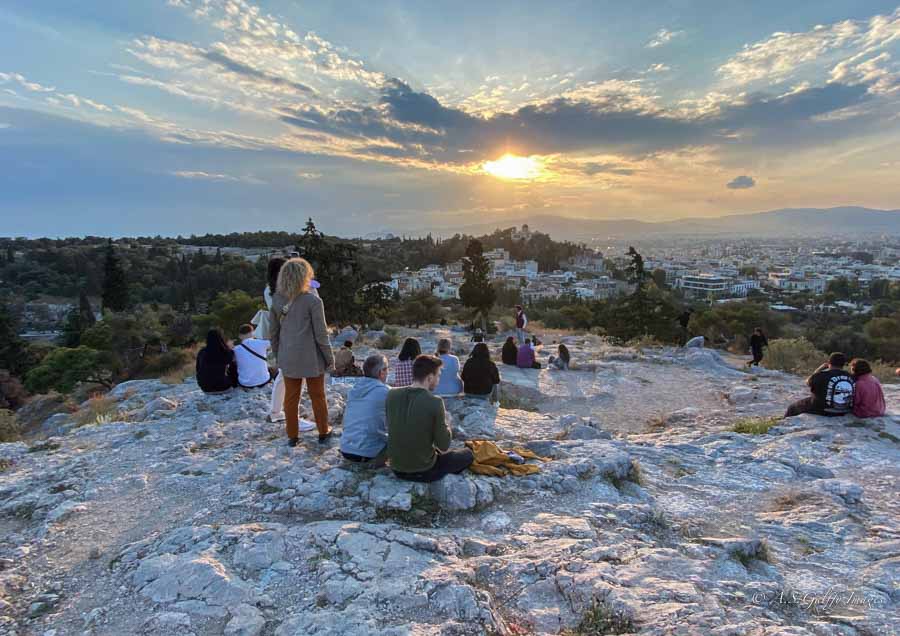
Where else but in the Peloponnese can you visit the birthplace of the Olympic Games? Or wander through the wilderness where the horned god Pan and his nymphs once danced? Wherever you go in this region of Greece you’ll have paths to explore and hidden treasures to discover.
But a road trip through the mainland and the Peloponnese is not only about discovering archeological sites, sunken cities, and Venetian castles. It is also about walking on blissful beaches, visiting quiet monasteries, tranquil seaside towns, and endless olive groves.
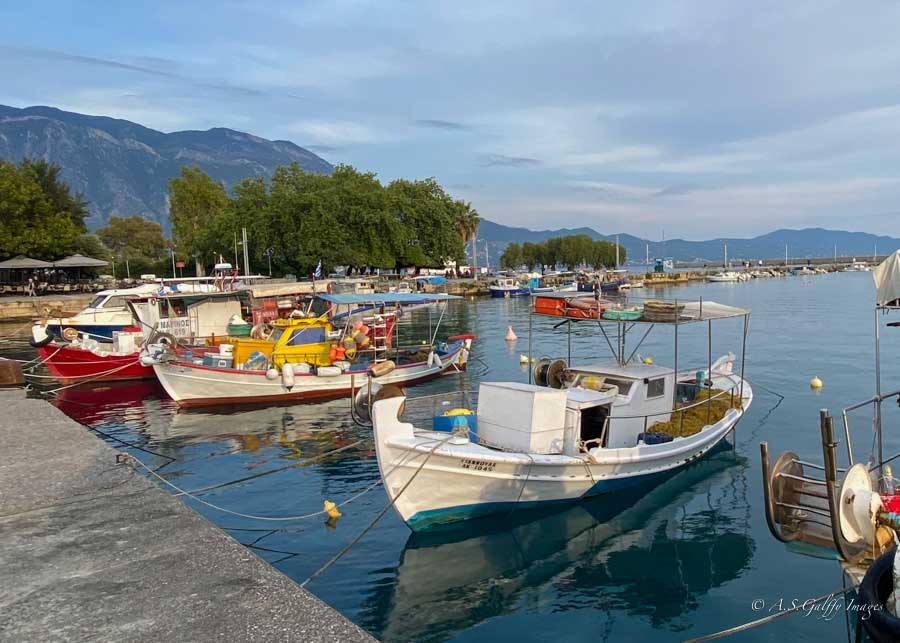
Unlike the Greek islands which constantly swarm with tourists, you’ll find plenty of space to breath in this part of the country. So if you are looking for the perfect Greece itinerary, you can’t go wrong with a road trip in the Peloponnese.
Useful Information for Planning a 2-Week Greece Itinerary
Best Time to Visit Greece
The best time to visit Greece depends a lot of what you want to see and do while there. If you are planning a road trip in the Peloponnese, the best time to do it is in spring or fall.
In April and May, or in late September and October the weather is pleasant, with comfortable temperatures (60ºF – 75ºF) and very little rain. This is a great time for hiking or visiting the archeological sites. Besides, in late May and sometimes till early October you may be even able to swim.
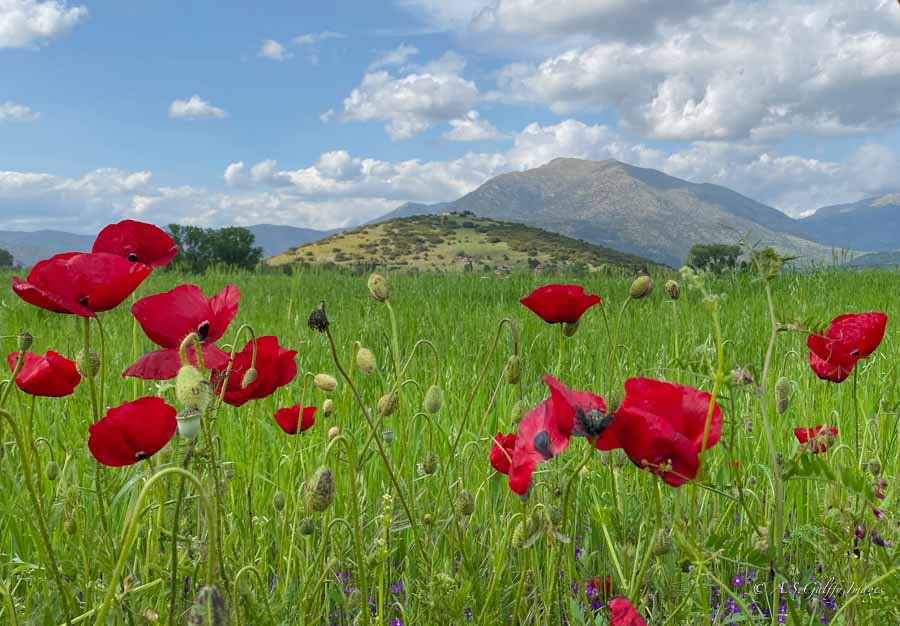
Winters on the other hand are chilly and wet in Greece, therefore not a great time for planning a 2-week itinerary. From November through mid-March you’ll see more rainfall and even some snow up in the mountains. This is not a great time to visit Greece, as many hotels may be closed for the season.
Summers can be brutal in Greece, with temperatures reaching 100°F/40°C. That’s especially true for the mainland and the Peloponnese, where the scorching temperatures and the severe drought often trigger devastating wildfires.
From mid June to mid September it’s almost impossible to walk outside during the day, or climb up the endless steps of the archeological sites. Summer may be a good time for the islands, but not for the Peloponnese.
Visa Requirements for Greece
Citizens of the European Union can travel to Greece with only a valid ID. No passport or customs formalities are required.
Citizens of the USA, Australia, New Zealand, or Canada only need a valid passport to enter Greece. However, visa-free travel only applies to stays of up to 90 days in any 180-day period.
Citizens of some countries may need a visa to enter Greece, so to learn if you need one you should contact the Greek Embassy in your country.
How to Get from the Mainland to the Peloponnese
The best way to travel to Greece is by plane. There are only 2 small airports in the Peloponnese (Patra and Kalamata) which run mainly in summer. So unless you are headed for the Greek islands, you’ll most likely land in Athens.

Athens Airport (ATH) is the largest and busiest international airport in Greece and is a hub for Aegean Airlines, Olympic Air, Ryanair, Volotea and Sky Express. The airport is located about 30 km (19 miles) east of the city of Athens and is very well connected to the city center.
To travel to the Peloponnese from Athens, you can take the train, the bus, or the ferry from Piraeus Port (which is close to Athens). However, the best way to visit the Peloponnese is by car.
Renting a Car in Greece
Greece was meant for exploring, and not just by bus or by boat. Visiting Greece by car gives you not only more comfort, but also a lot of flexibility with your 2-week itinerary.
We rented a car at Athens airport upon arrival. Although we didn’t use it in Athens, renting it for the entire time proved cost effective since we didn’t have to pay for a cab to or from the airport.

It is also possible to rent the car in Athens, after you finish exploring the city. There are some car rental agencies in the city center, but their prices are higher than the ones at the airport. But no matter where you rent your car, just make sure you opt for a small and fuel-efficient one that is easy to drive and park on narrow roads.
Driving in Greece
If you are planning a 2-week road trip itinerary in the Peloponnese, you probably have a lot of questions about driving in Greece. How challenging is it? Are Greek drivers aggressive? How about unmarked roads, or highways signs written with Greek characters only?
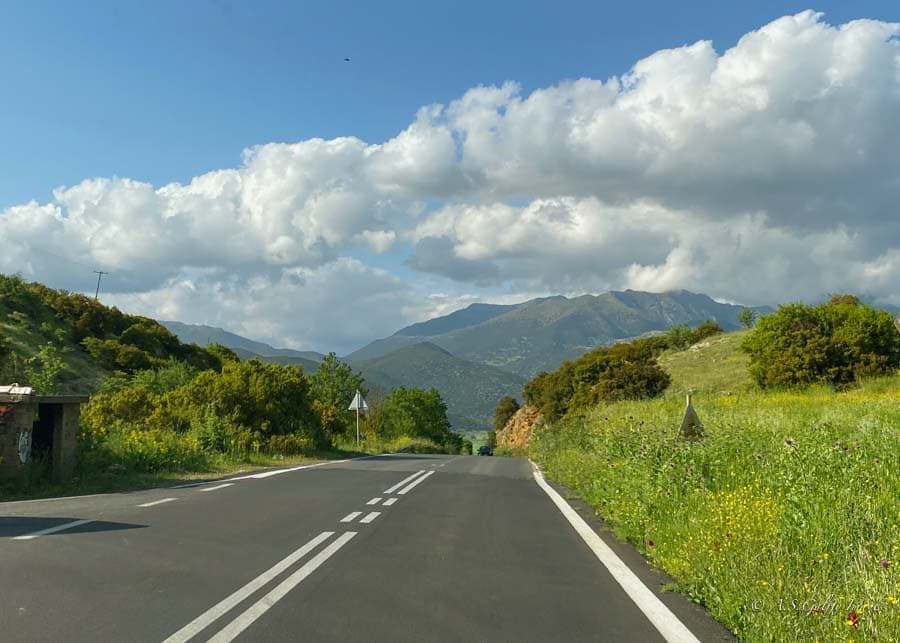
Well, when compared to driving in Sicily touring the Peloponnese by car looks like Heaven! The main roads are well maintained, smooth and easy to navigate. Also, except for very few remote places, all roads are marked with Latin alphabet as well. Sometimes even in the tiniest villages!
There are also many toll roads in the Peloponnese, so we used them often as they are less crowded and more convenient. That being said, we also came across winding mountain roads and narrow streets, like in many parts of Europe.
As for the Greek drivers, they are fast but not aggressive. On the contrary, we found them to be very considerate to others. Whenever we reached someone from behind, they always moved over to the right side so that we can pass.
About This Peloponnese Road Trip Itinerary
Our 2 weeks itinerary took us on a loop of all the popular sights throughout the Peloponnese, starting and ending on Greece’s mainland, in Athens. Depending on how much time you have available, you can adjust this itinerary by extending or reducing the route.
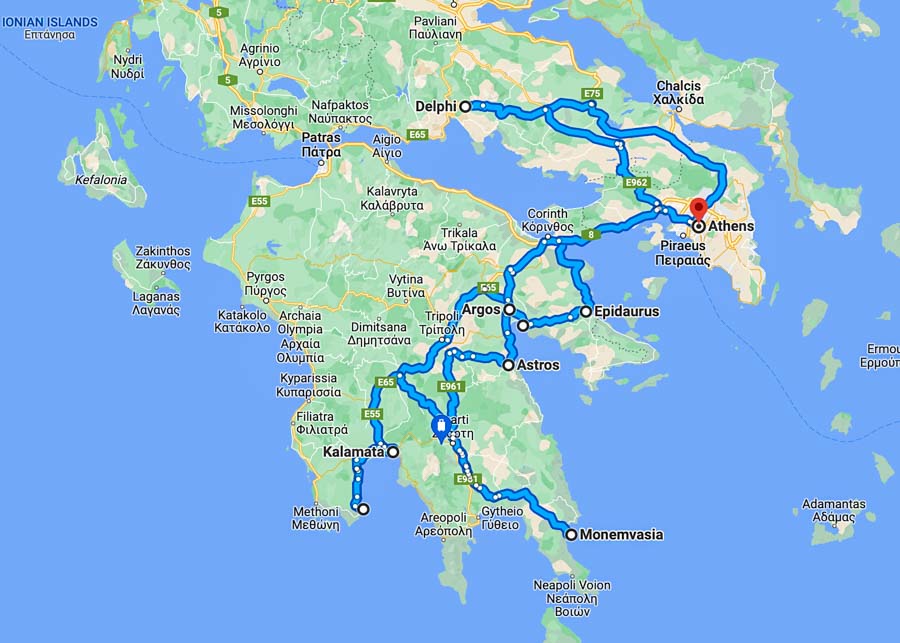
Itinerary Summary: Athens → Delphi → Corinth Canal → Akrocorinth → Mycenae → Nafplio → Argos → Epidaurus → Kalamata → Koroni → Gytheio → Mystras → Sparta → Monemvasia → Messene → Methoni → Arcadia → Mantinea → Tegea → Astros → Ano Doliana → Athens
We designed this 2-week Greece itinerary in such a way that you won’t have to move around unnecessarily. We chose 3-4 towns as a home base from where we took day trips. The sites we visited were within a 50 to 80 km radius (45 minutes – 1.5-hour drive).
Greece Mainland & Peloponnese road trip itinerary
Days 1 to 3 Itinerary – Athens
Our 2 weeks road trip itinerary started in Greece’s mainland and continued in the Peloponnese. We spent the first 4 days in Athens, from where we also took a day trip to Delphi. That gave us 3 full days in Athens. This was enough time for visiting the archeological sites, the main museums, and get a glimpse of Athen’s most popular neighborhoods.
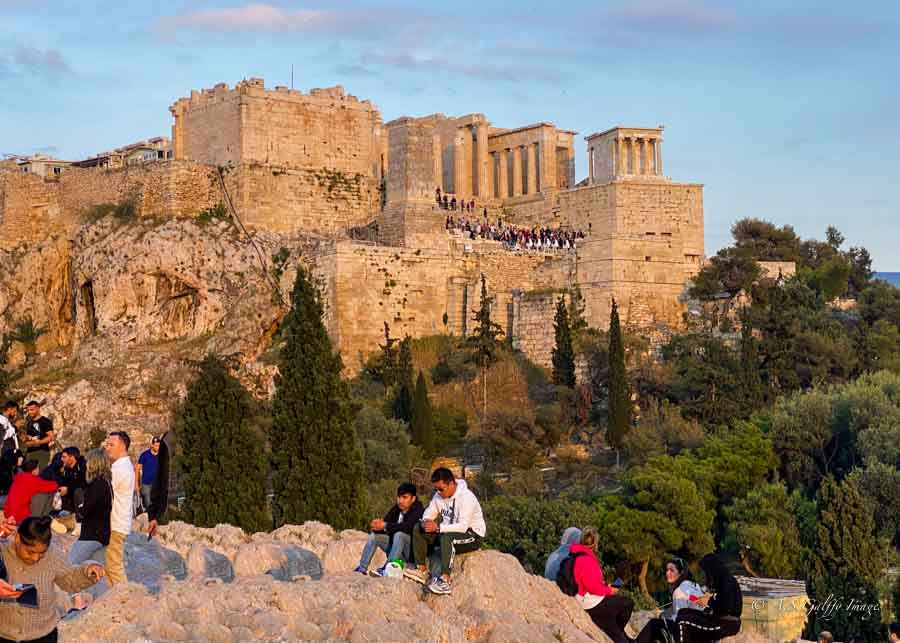
Important Sites to Visit in Athens
Despite being kind of a mixed bag, we enjoyed Athens a lot. There are a few important sites that you definitely shouldn’t miss if you visit the Greek capital. They include the Acropolis archeological site and Acropolis Museum, the Roman Agora, Hadrian’s Library, Ancient Agora, the National Museum of Archeology and Lycabettus Hill.
There are of course many others to visit if you like history and archeology. Also don’t miss the picturesque neighborhoods of Plaka and Anafiotika, as well as the city’s two famous squares – Monastiraki and Syntagma.
Where to Stay in Athens
If you are a visitor to Athens you should aim to stay in one of the walkable neighborhoods like Syntagma, Monastiraki, Plaka, Psirri, or Koukaki. While you won’t be able to walk quite everywhere in Athens, staying close to the City Center will give you easy access to the Acropolis, Agoras, and many of the museums.
Day 4 Itinerary – Delphi
Delphi was an important ancient religious sanctuary dedicated to the god Apollo. According to Greek mythology, Apollo killed the massive snake Python at Delphi. Following his victory, the Greeks erected a temple and an oracle on this site.
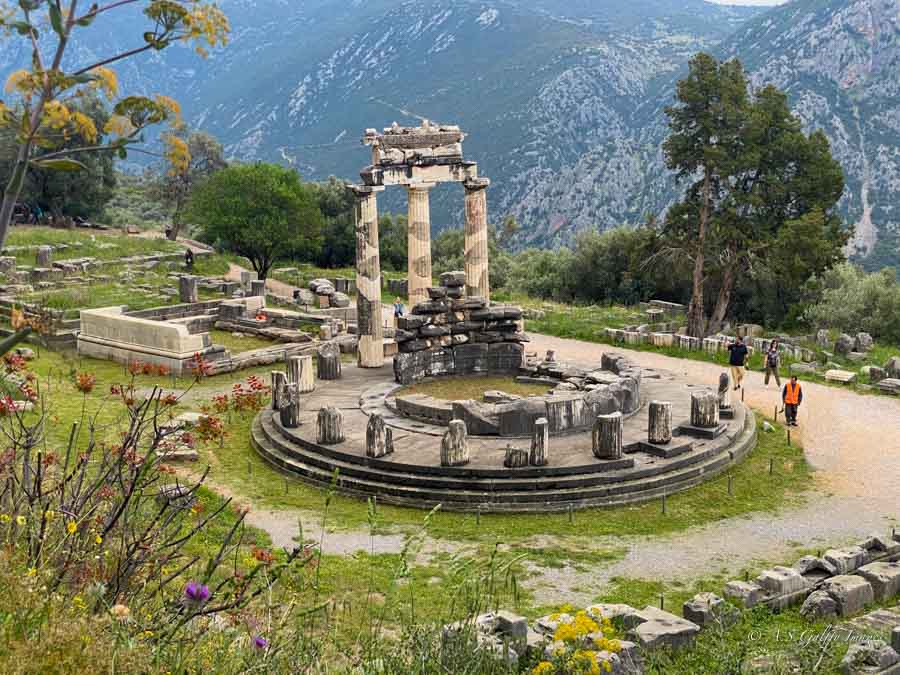
The oracle was very famous in Ancient Greece. Pilgrims from all over the Mediterranean would visit it to receive the prophecies of Apollo, delivered through the words of Pythia, the high-priestess of his temple.
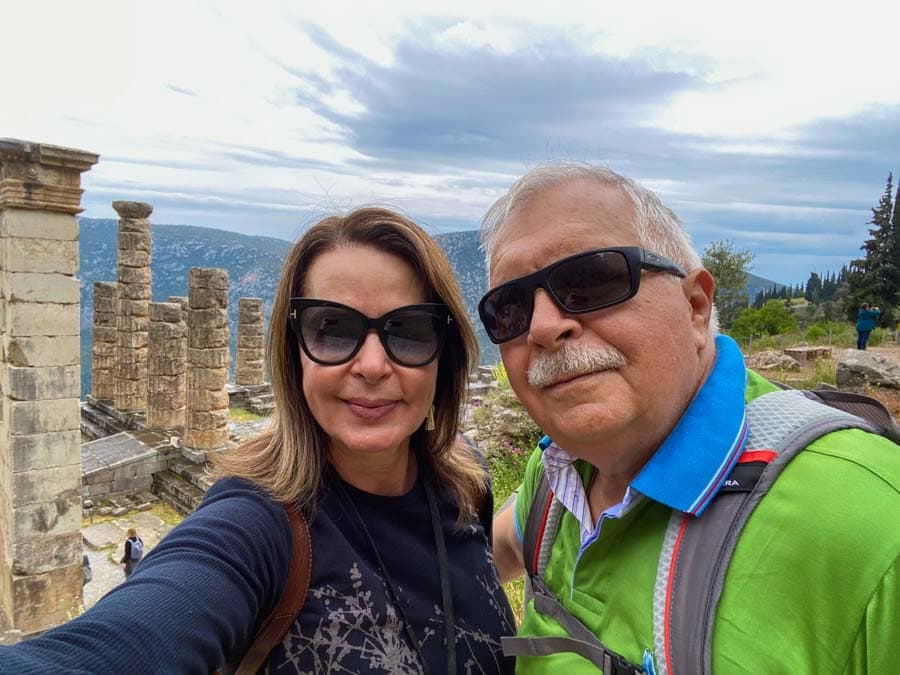
Delphi is one of the most spectacular archaeological sites in Greece, next only to the Acropolis of Athens! For this reason, people who don’t have time for a long road trip, choose to visit Delphi as a day trip from Athens.
Day 5 Itinerary – Akrocorinth & Mycenae
After 4 days on the mainland, our road trip itinerary continued across the Corinth Canal into the Peloponnese. We spent the fifth day visiting the Canal, and the archeological sites of Ancient Corinth and Mycenae.
The Corinth Canal
The Corinth Canal, which was inaugurated in July, 1893, is an artificial canal cut through the isthmus of Corinth. The Canal links the Ionian Sea with the Aegean, effectively turning the Peloponnese peninsula into an island.
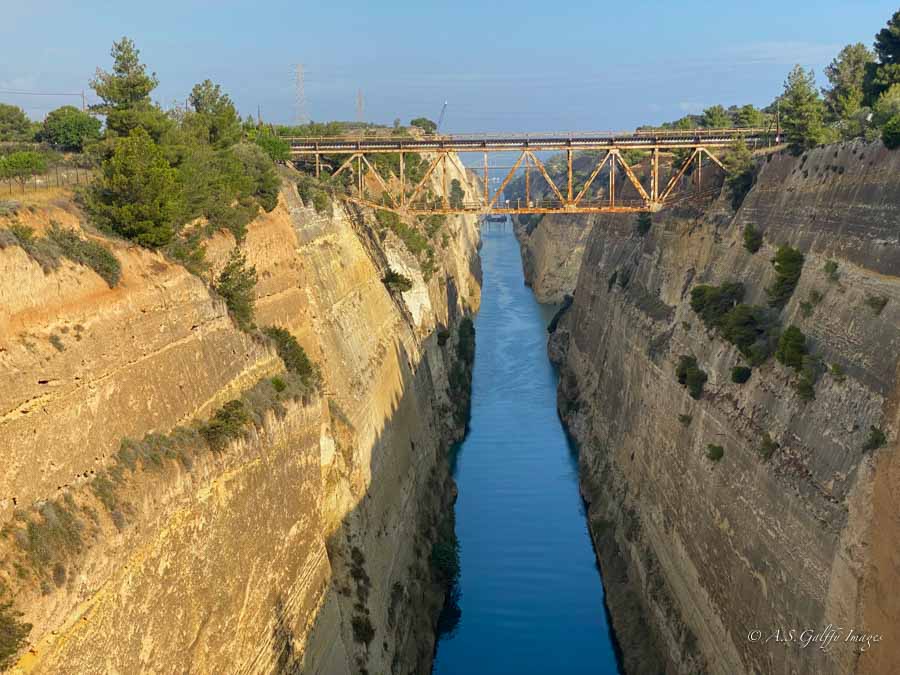
It’s astonishing to realize that this narrow waterway with rocky walls saves ships a nearly 400-mile journey around the tree leaf-shaped cape!
Ancient Corinth & Akrocorinth
The archeological site of Ancient Corinth is just within a short drive from the Canal. In ancient times, Corinth was one of the richest and most powerful cities in the Mediterranean.
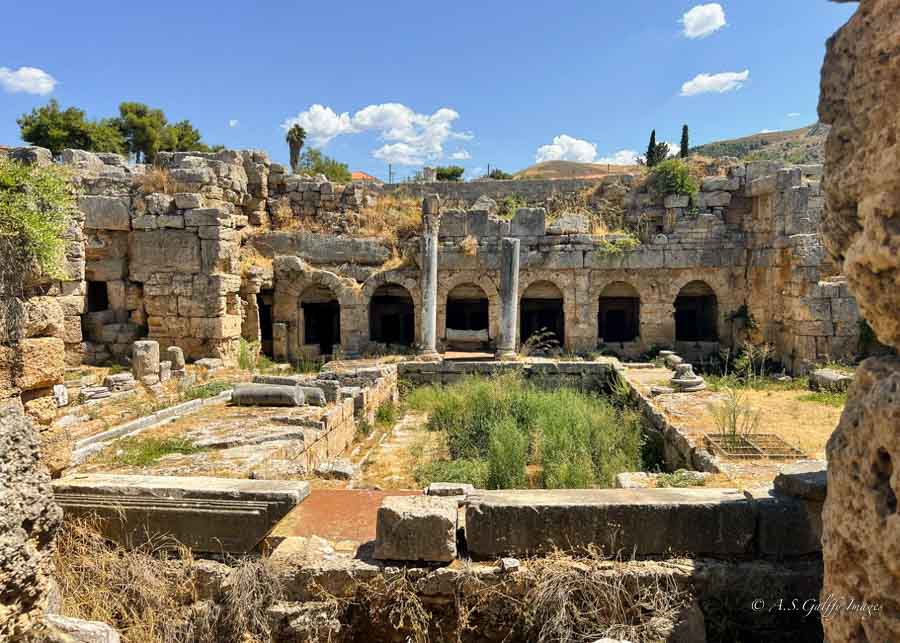
The most striking monument you’ll see here is the Apollo Doric Temple, which dates back to around 500 BC. Looking at it you can only imagine how magnificent Corinth must have been in those times!
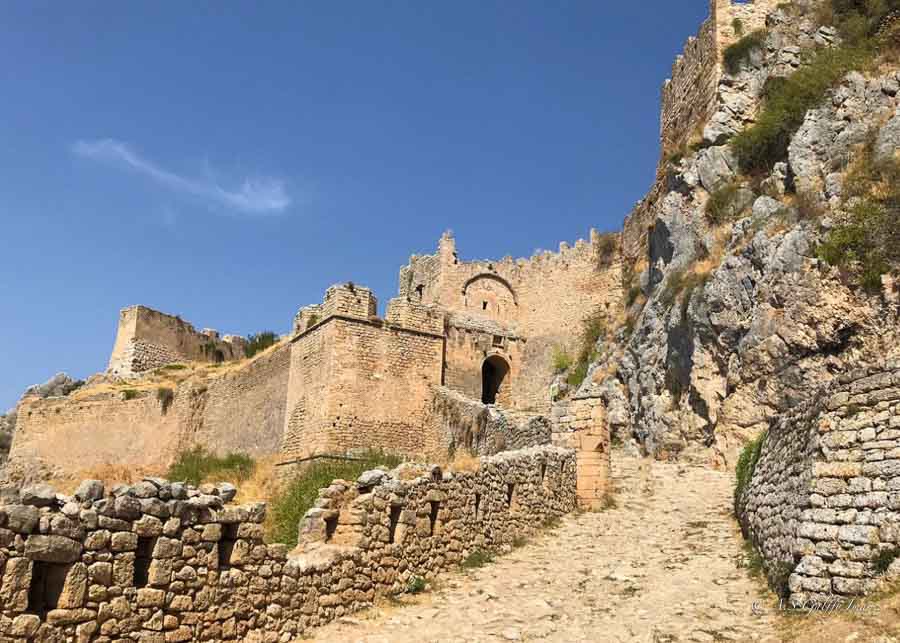
But the most interesting site to visit in Corinth is actually the Akrocorinth, which is only 10 minutes away from the Ancient Corinth. Here, standing high up on a rock, you’ll see the largest and most important fortification in Greece.
Mycenae
The archeological site of Mycenae holds a lot of history! During the Early Bronze Age this was home to one of the greatest civilizations of Greek prehistory – the Mycenaean civilization. According to legend Mycenae was the capital of Agamemnon, the ancient Greek king who conquered the city of Troy.
Not much has survived from the Mycenaean civilization though. The two structures still standing today are from the 14th century B.C. One is the Lions’ Gate, at the entrance of Mycenae’s citadel.
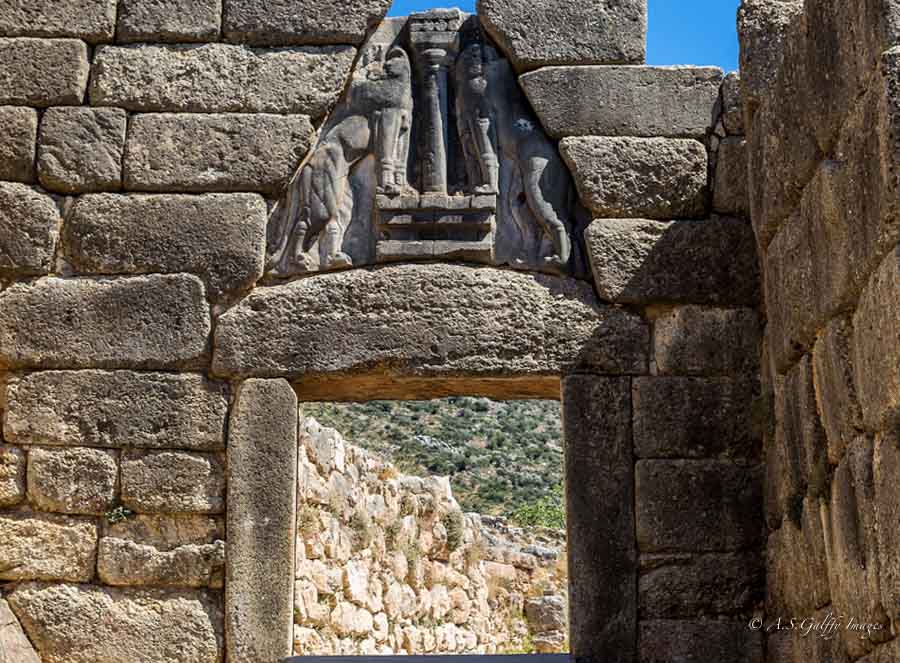
The other is the Tomb of Agamemnon – a beehive burial chamber built up of overhanging blocks of masonry. But despite the name, little is known of the persons who might have been buried in this tomb.
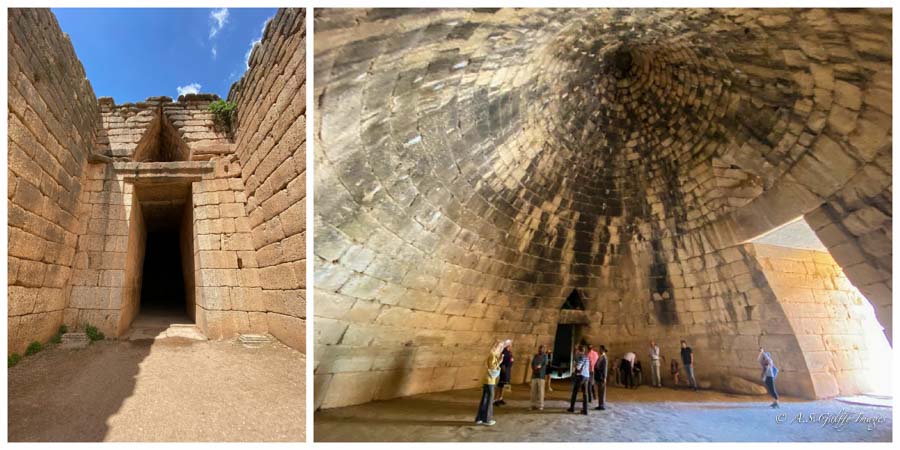
Day 6 Itinerary – Nafplio
Nafplio is the most beautiful seaside town in Greece’s mainland, totally worth including in your 2 weeks itinerary. Nafplio has everything you could want in a coastal town: beautiful beaches, walkable streets, buzzing squares, a vibrant port, an offshore island fort and two hilltop castles.
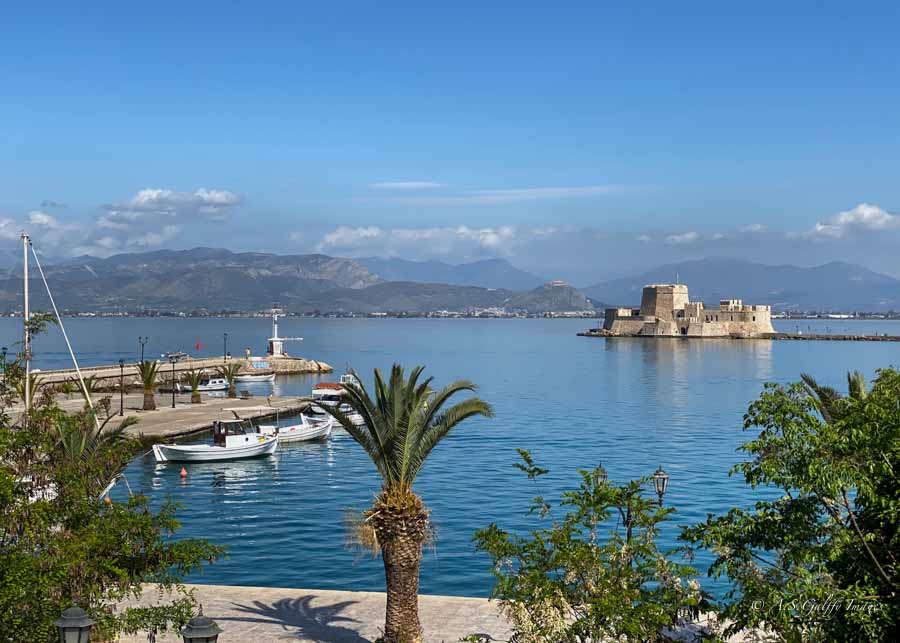
We spent 3 days here, which seemed very little considering how beautiful this town is. From Nafplio we took day trips to Argos and Epidaurus and spent a full day to visit the town’s attractions.
Nafplio is home to three important fortresses: the imposing Palamidi castle, the fortress of Acronafplia and Bourtzi Castle. There is also has a lovely seaside promenade worth seeing, very similar to Croatia’s famous Lungomare. This lovely costal alley carved in rock connects the town’s small port with the beach of Arvanitia.
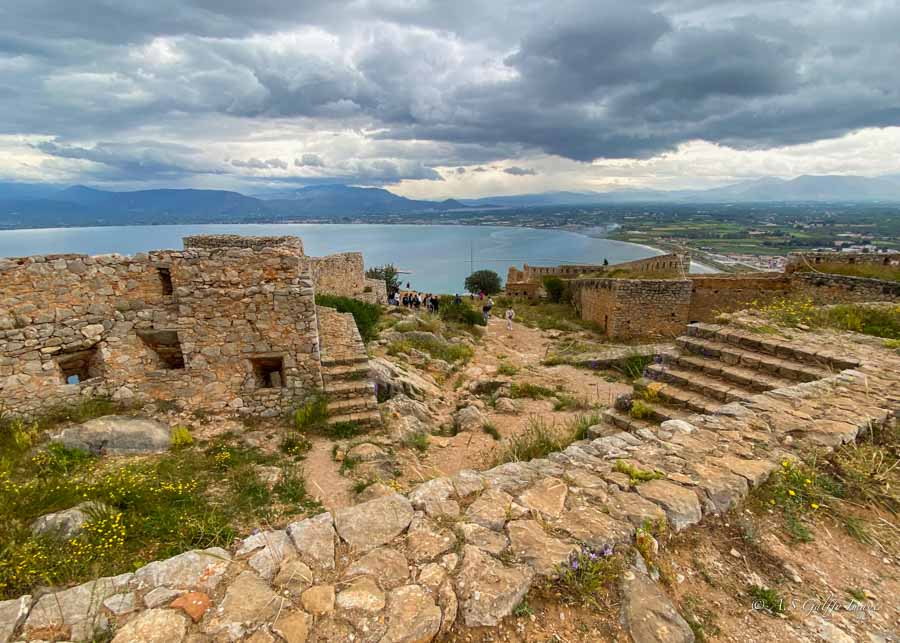
Where to Stay in Nafplio
The Old Town is the most romantic part of town and one of the best places to stay in Nafplio. We also recommend the hotels in the port area, which are just a few steps away from the Old Town.
Day 7 Itinerary – Argos & Epidaurus
Argos
Argos claims to be the oldest city of Greece. There is indeed evidence of an old settlement in this area that dates back to the Neolithic (around 5000 BC). This town is just a short distance away from Nafplio (12 Km) and it’s really worth visiting.
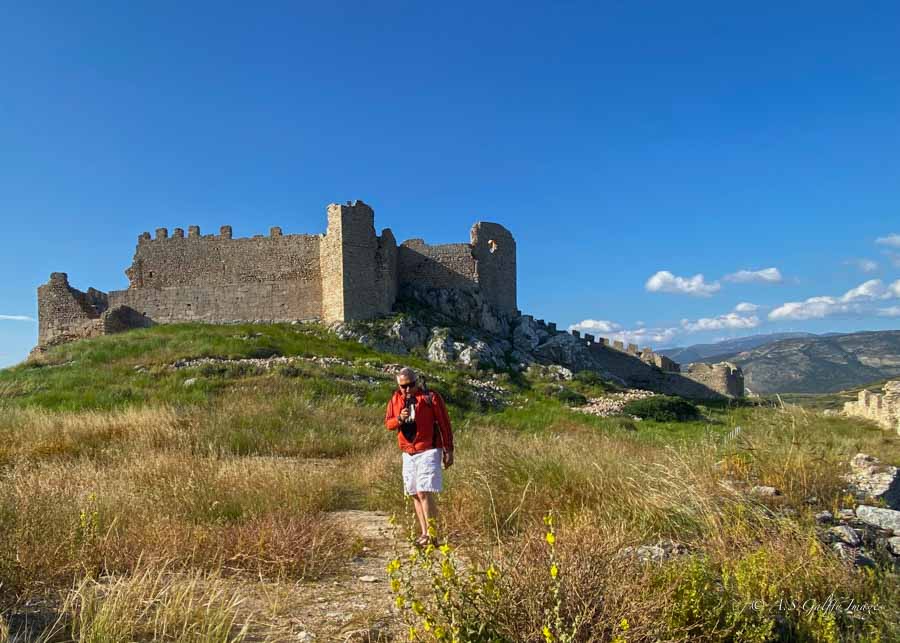
The top attractions to visit in Argos include the Archeological Site of Fort Larissa, the Ancient Theatre of Argos, and the Byzantine Museum of Argolis.
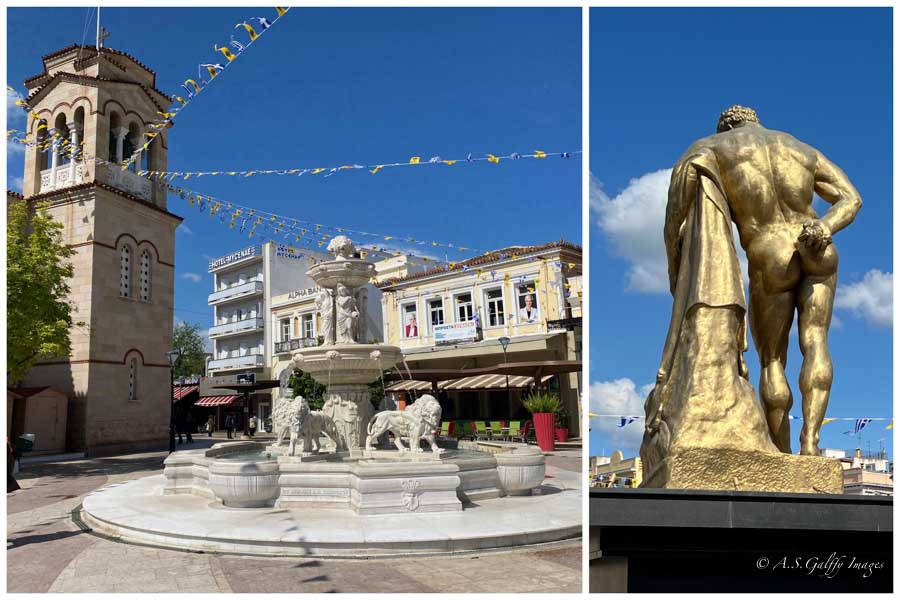
Downtown Argos is also nice to stroll if you want to see the Statue of Hercules, near the old town hall. This is exact copy of the statue created by the ancient Greek sculptor Lysippos.
Epidaurus
Another beautiful stop on our 2 weeks Greece itinerary was the ancient city of Epidaurus, famous for its perfect-acoustics theater. This UNESCO’s World Heritage Site is part of the Sanctuary of Asclepius, the Ancient Greek god of medicine.
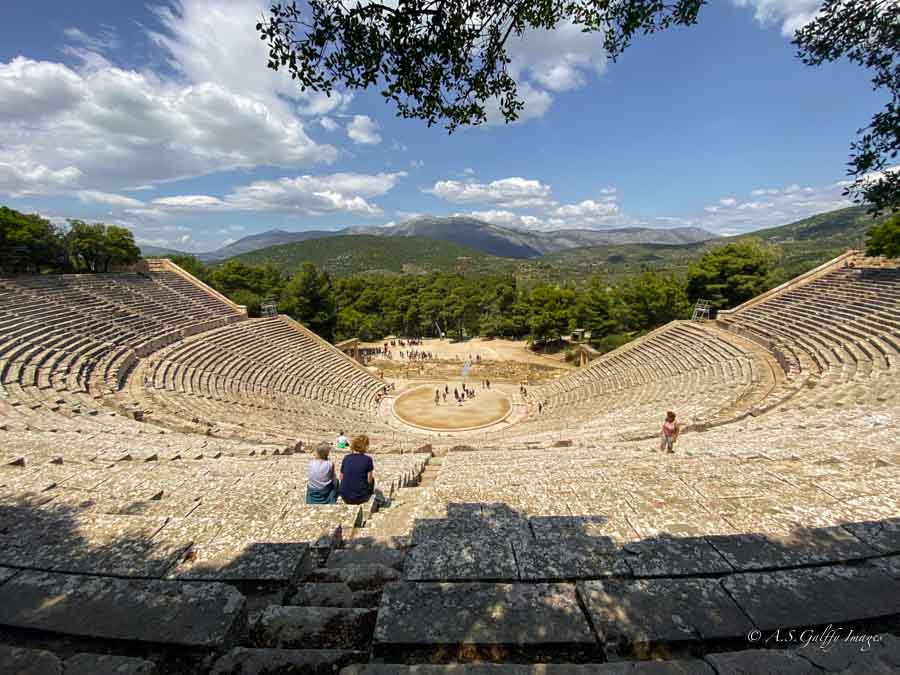
But few visitors know that just a little beyond the renowned Theater there is an ancient sunken city. Although not a huge site, the underwater city of Epidaurus is fun and easy to explore. The ruins are very close to the shore and just 2 meters below the sea level.
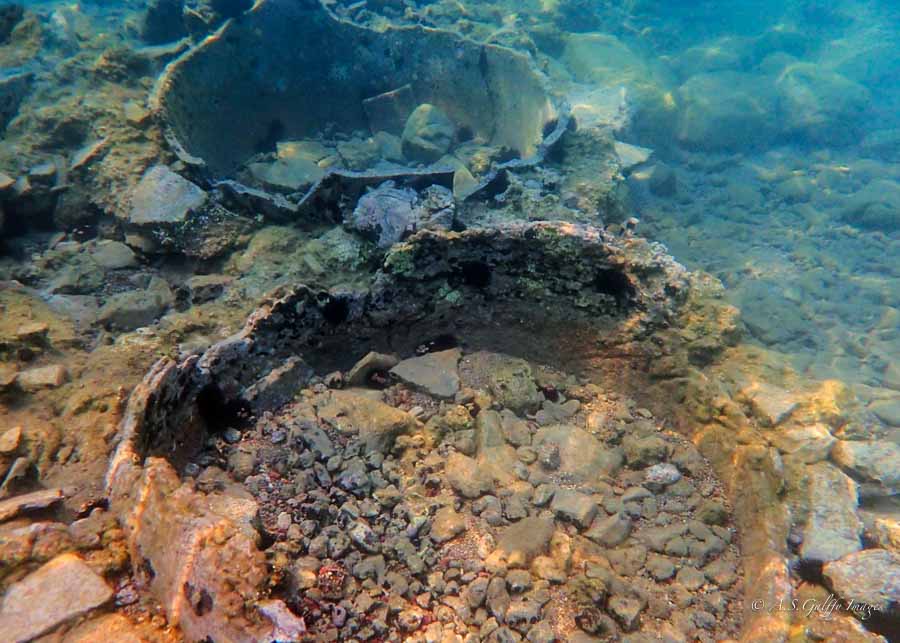
If your trip through the Peloponnese takes place in summer, when the water is warm enough to swim or snorkel, you should make it a point to visit this site.
Day 8 Itinerary – Kalamata & Koroni
From Nafplio, our road trip itinerary continued to Kalamata, another town that we used as a home base for our day excursions in the Peloponnese. We stayed here for 4 days and visited the towns of Koroni, Gytheio, Mesene, Methoni, Mystras, Sparta, and Monemvasia.
Kalamata
The town of Kalamata is mostly famous for being home to the best olive type in the world, the ‘Kalamata Olives‘. There is not a lot to see here, other than the port area, the old town, and the ruins of a small castle.
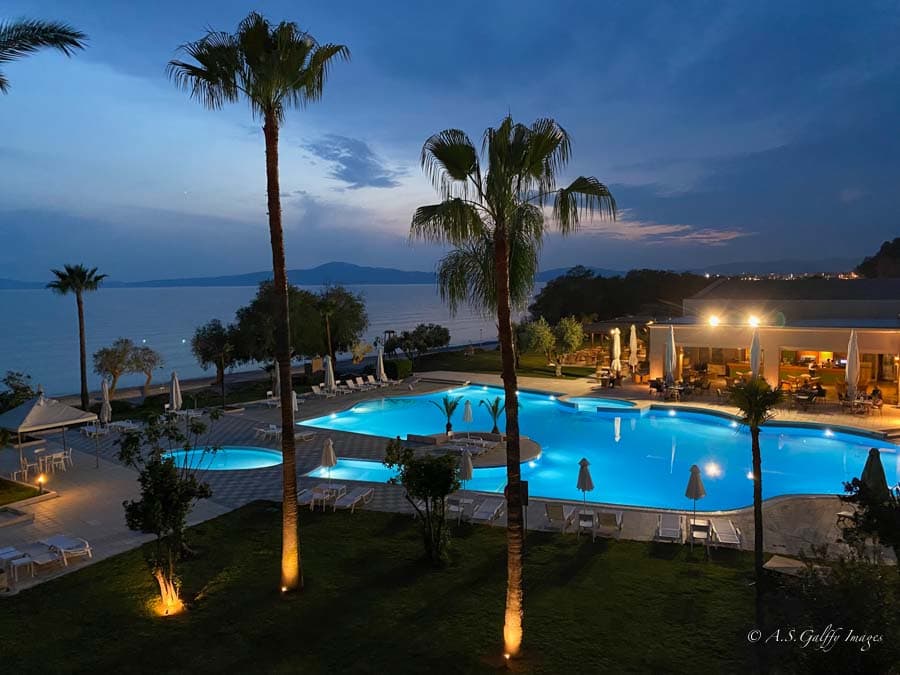
The Castle of Kalamata sits up on a hill overlooking the historic center. The structure that you see today was built by the Franks in the 13th century, on the ruins of a Byzantine fortress.
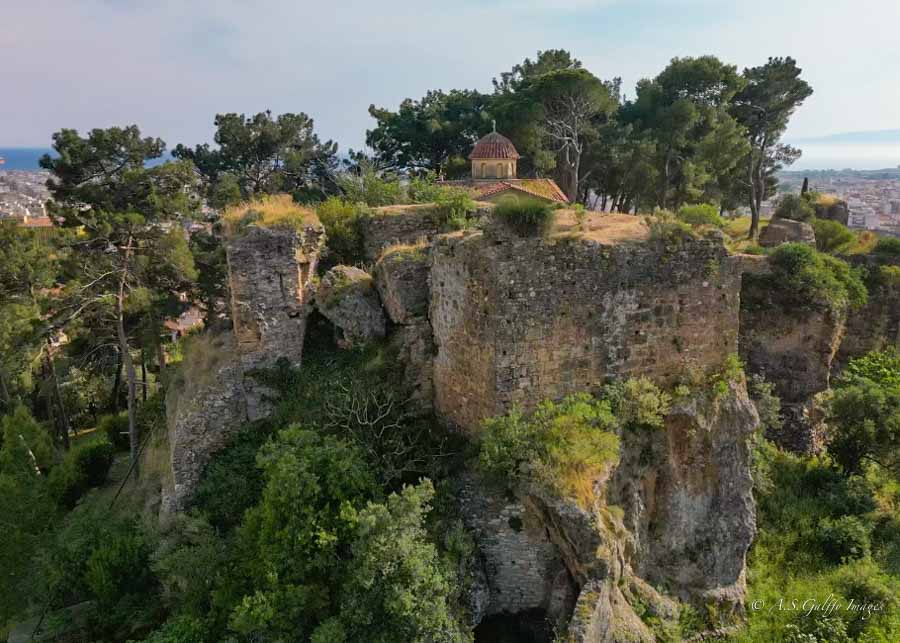
Within the castle walls there is a small chapel devoted to Virgin Mary which dates back to the 6th century A.D. Also, at the top of the hill there is a water reservoir which contains the ruins of an ancient temple.
Where to Stay in Kalamata
There is a good range of accommodation in Kalamata. You can choose from small hotels and Airbnb apartments, to elegant hotels and resorts. As far as the best area, it depends on the purpose of your visit. The old town has better food choices, while the seafront is nicer and closer to the beaches.
We stayed at Grecotel Filoxenia, a mid-range hotel with a private beach. This hotel is also very close to the highway, which makes it easy to get in and out of town. That’s extremely convenient if you are using Kalamata as a home base for taking day trips in the Peloponnese.
Koroni
Koroni is a small and unassuming beach town with a nice waterfront and sheltered harbor, full of colorful fishing boats. What made us add it to our itinerary was actually a picture of its hilltop citadel that we saw in a Greece Travel Magazine. And we did not regret visiting it.
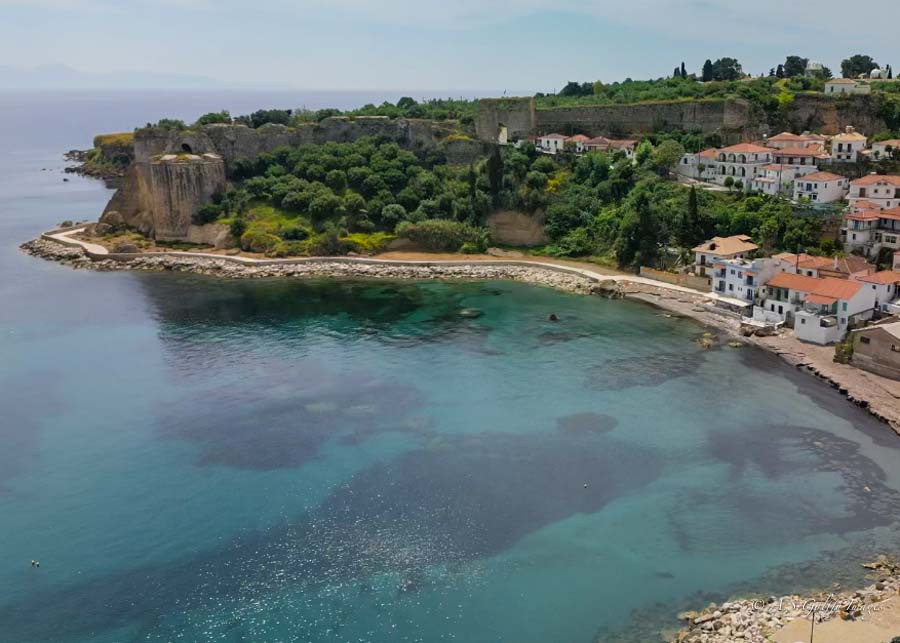
This impressive fortification existed since the 7th century AD. But the structure of Koroni castle that you see today was erected much later by the Venetians (13th century). A series of wide, paved steps lined with white-washed houses lead to the main gate of the castle.
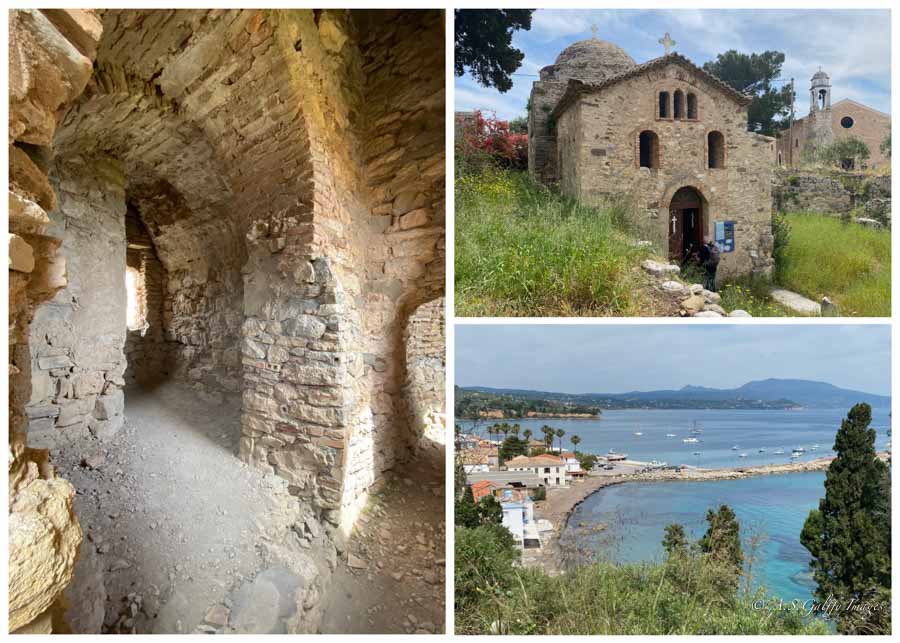
Inside the castle you’ll see the church and cemetery of Agios Haralambos and the interesting “old-calendar” monastery of Agios Ioannis. Next to the monastery are the ruins of Agia Sophia, a beautiful Byzantine church built in the 12th century over the remains of an ancient temple.
Day 9 Itinerary: Messene & Methoni
On the 9th day of our itinerary we drove to Messene and Methoni, two of the major sites in the Peloponnese.
Messene
Ancient Messene is often overlooked by tourists, although it’s one of the most impressive archeological sites in Greece. The only explanation is that probably not many people know about it, although the site is quite large and extremely well preserved.
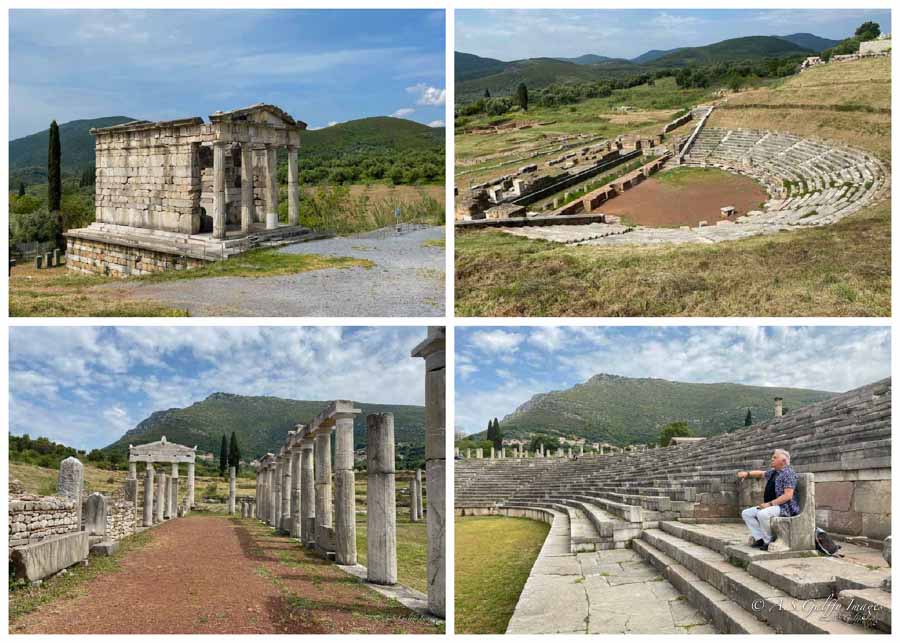
Messene is set in a stunning location and includes a a great deal of structures. There is a small theater, several temples, a large stadium, the Sanctuary of Zeus Ithomatas, a basilica, the restored Saithid Mausoleum, a grave monument and several mosaics.
Methoni
The sea-castle that dominates the small village of Methoni is still one of the most most beautiful castles in Greece. The castle – actually a fortified city – was built by the Venetians around 1209, on a rock that penetrates into the sea.
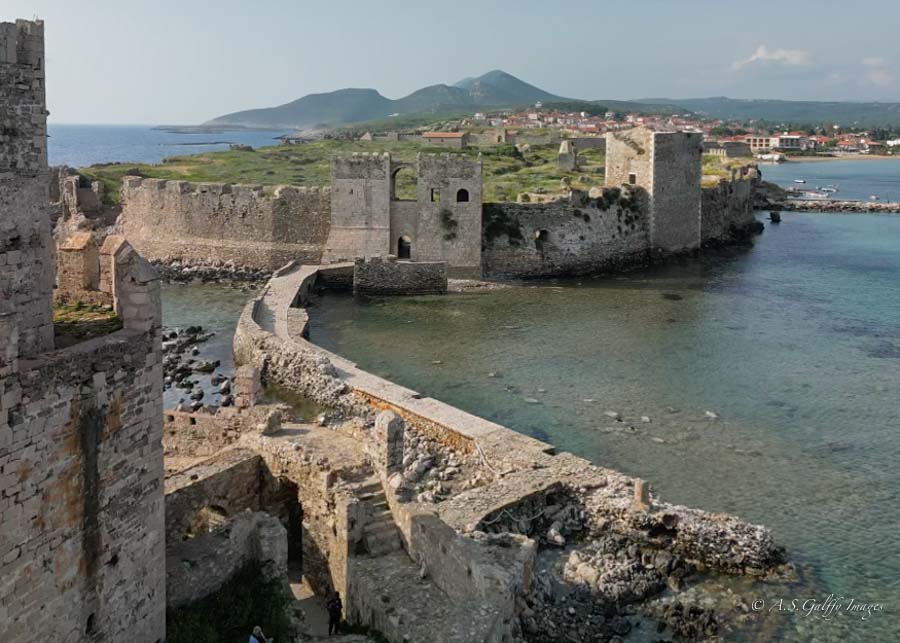
Access to the castle is by a stone bridge built over a moat. Inside the fortification are the ruins of the houses where the Venetian lords lived, paved streets, remnants of a Turkish bath, and a Byzantine church. While the majority of the site is in ruins, you can still get a sense of the once majestic structures.
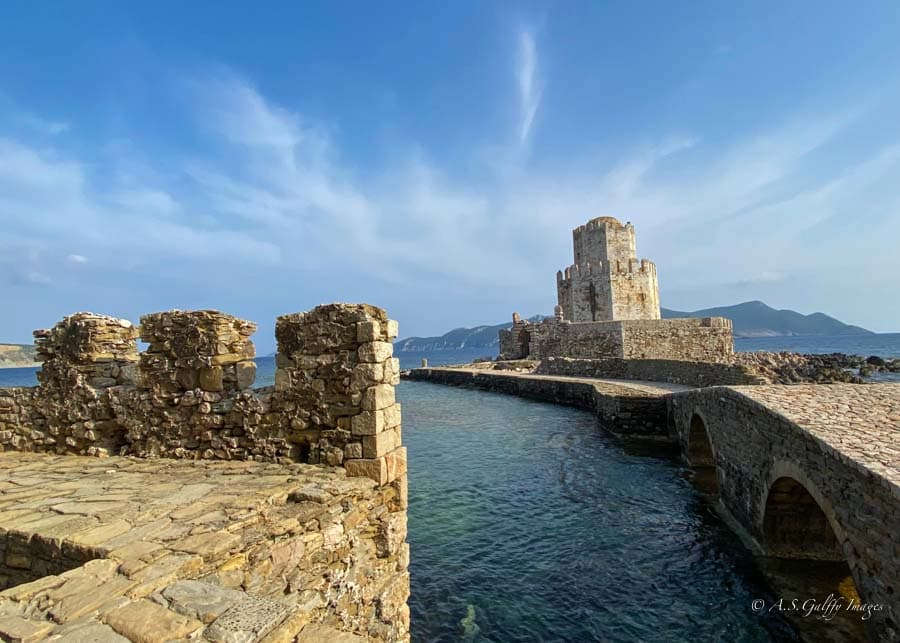
The highlight of the castle is undoubtedly the Bourtzi, an octagonal tower that you will arrive at after walking through the castle interior. Another interesting feature to look for are the carved winged lions, a symbol of the Venetians’ power.
Day 10 Itinerary – Mystras & Sparta
Mystras
Mystras (a UNESCO World Heritage site) is by far one of the most spectacular sites we visited in the Peloponnese. There is a reason why they named it ‘The Wonder of Morea.”
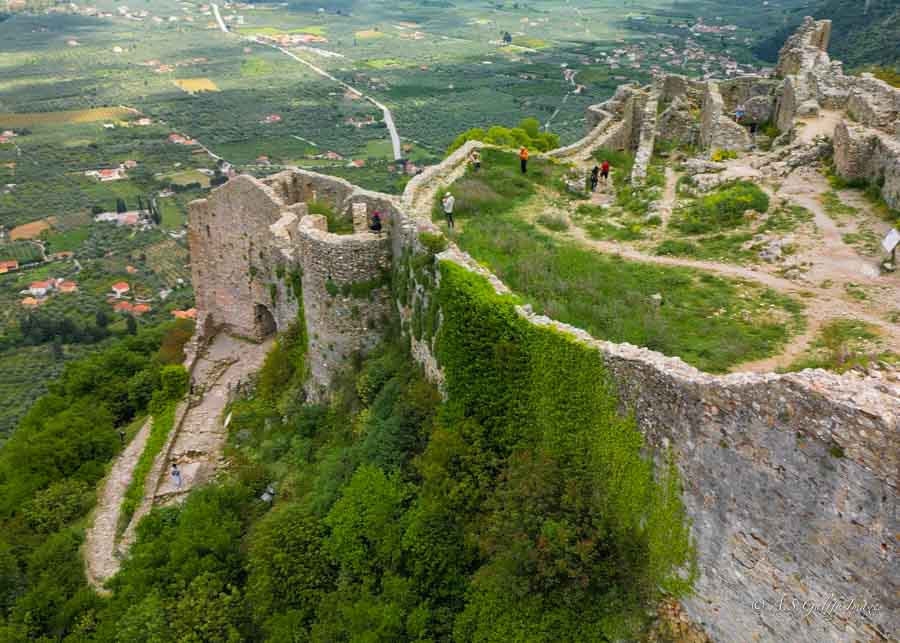
Mystras was a major center during the late Byzantine empire and its remarkable architecture and religious artwork attest to its importance.
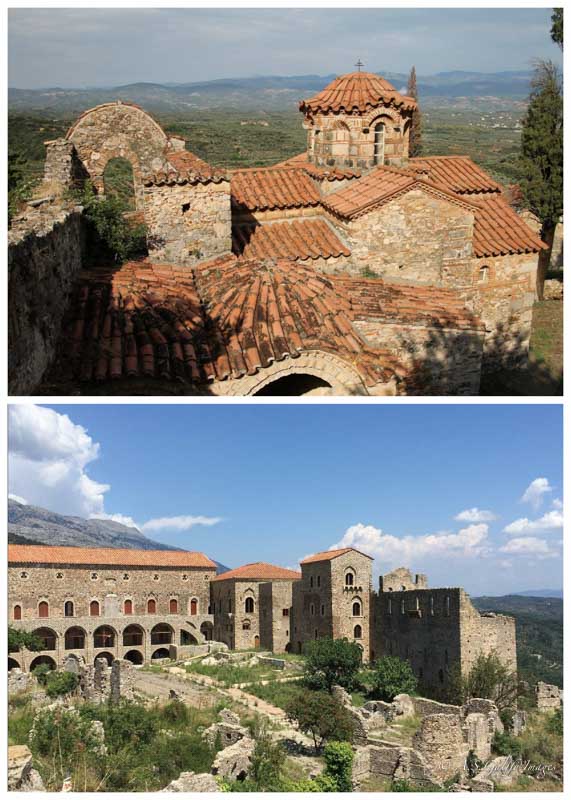
The site is really big, so you should try to arrive here early. Also be prepared for some serious hiking. In addition to the castle, there is a wonderful collection of churches in Mystras. Some are collapsed ruins, but others are intact and showing their age beautifully. There is also a functioning convent.
Sparta
The nearby archeological site of Sparta is another important destination worth adding to your Peloponnese road trip. The kingdom of Sparta was famous for its military discipline, which gave it strong advantage over other Greek city states.
Unfortunately, the site was already closed when we arrived. From all we could see from outside the gate, there is not much left of Sparta’s days of glory. Even so, if you are in the area I encourage you to visit Sparta.
Day 11 Itinerary – Gythio & Monemvasia
Gythio
Gytheio (or Gythio) is a pretty coastal town with a very authentic atmosphere, great tavernas and long sandy beaches. While Goth may not be a major site in the Peloponnese, we added it to our road trip itinerary for two reasons.
One was the tiny island of Cranae, which you can easily reach on foot by crossing a small pier at the southern part of town.
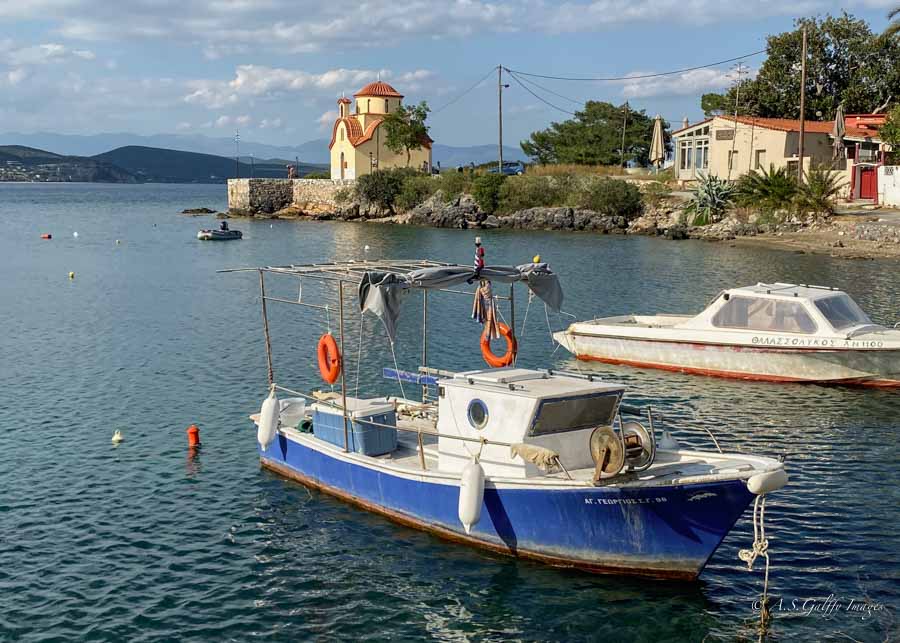
The island is closely associated with the Greek mythology. According to legend, Cranae was the place where Paris of Troy brought Helen after abducting her from her husband, King Menelaus of Sparta. The two lovers spent their first night together on this island before departing for Troy, thus igniting the Trojan War.
The second reason to visit Gythio is the Agios Dimitrios shipwreck, an imposing cargo ship from the 20th century that lies abandoned near Valtaki beach.
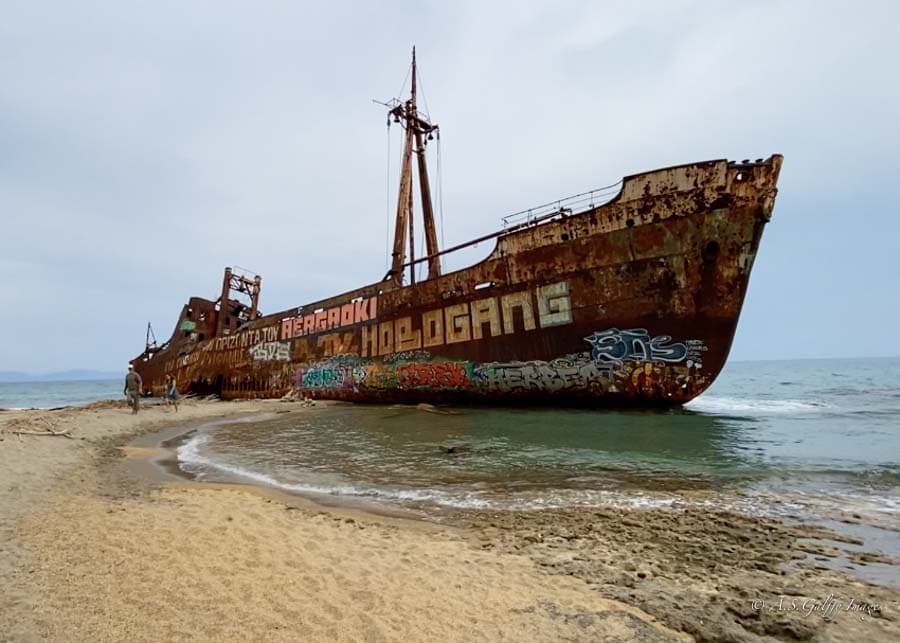
There are some stories that connect the ghost ship to some illicit trade and cigarettes contraband. But in reality, the cargo ship docked in an emergency in the port of Gythio as the captain fell ill.
Due to financial problems, the owners basically abandoned the freighter in the port, from where a storm swept it away. Eventually the abandoned ship washed up on the beach of Valtaki, where it has been since 1981.
Monemvasia
Monemvasia was one of the most memorable places we visited during our 2 weeks in Greece, so I wish I planned more time for it on our itinerary. This is a breathtaking medieval castle-town surrounded by crystal-clear waters and unforgettable views.
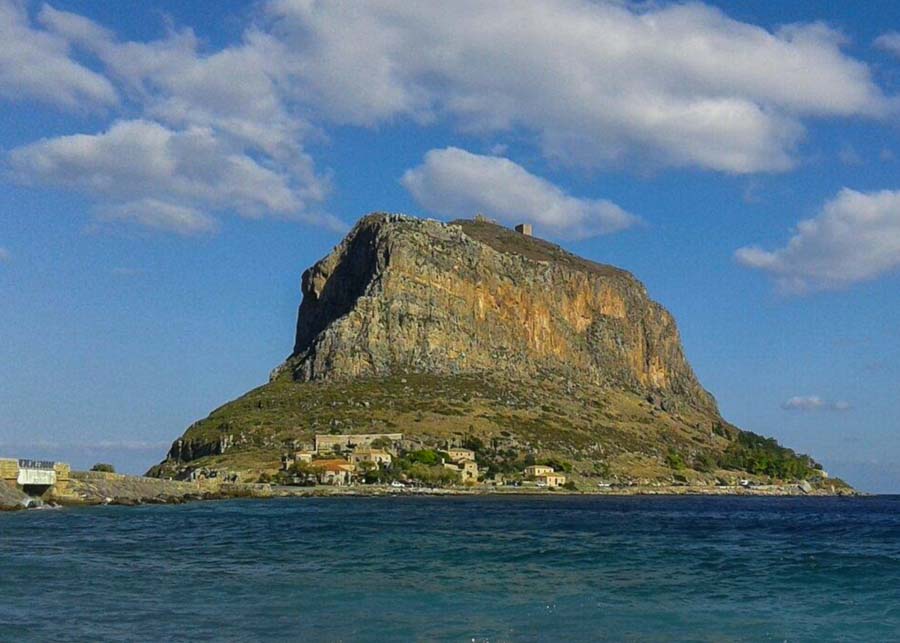
The main attractions in Monemvasia are the medieval town inside the castle walls, and the crumbling ruins of the ancient Byzantine fortress perching on the very top of this huge iceberg-shaped rock. Monemvasia was once a very powerful city in Greece, and all these remnants are a proof of that.
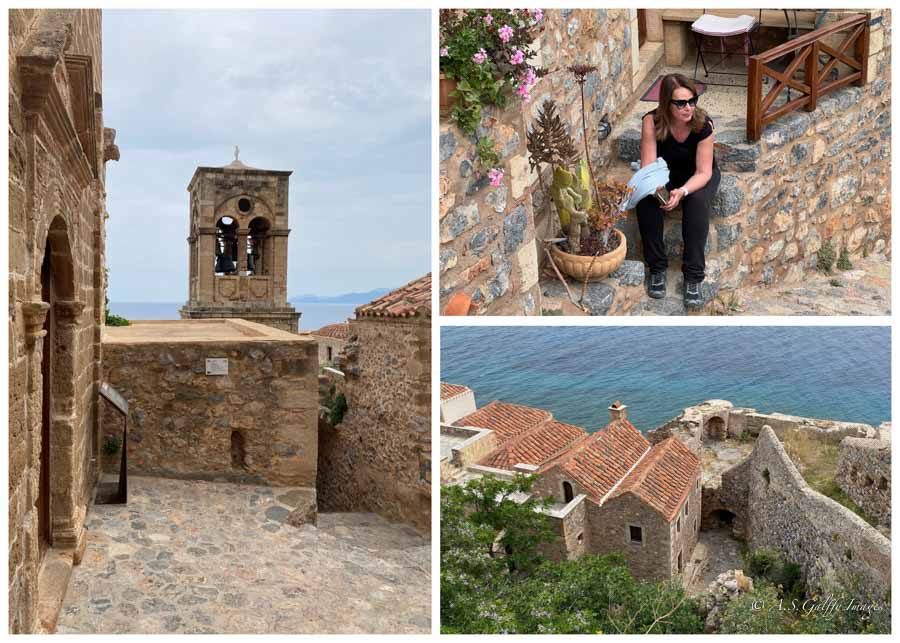
In the lower section of Monemvasia the buildings are still intact and inhabited by locals. The narrow streets are paved with cobblestone and lined with souvenir shops and tiny eateries. There are a couple of nice churches to visit in this section.
To reach the upper part you’ll have to climb up many steeps stairs, some of which are literally hanging on the walls of the fortress. But the effort is well worth it.
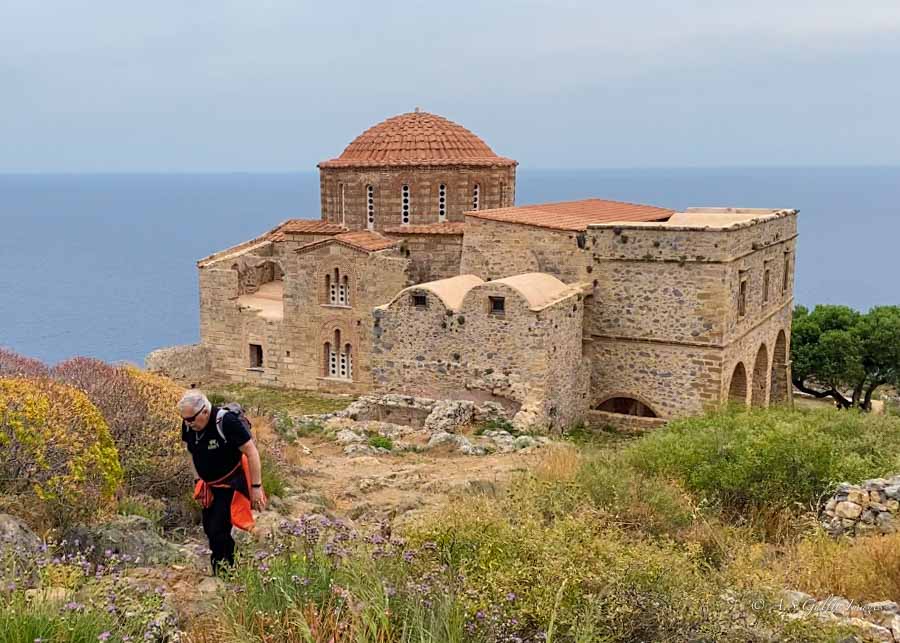
In this part of town you’ll discover the beautiful church of Agia Sofia, as well as many old structures that have been abandoned but are still in good shape.
Day 12 Itinerary – Tegea & Mantinea
We spent the 12th day our our 2-week Greece itinerary visiting the beautiful region of Arcadia. Surrounded by mountain ranges, Arcadia is an idyllic haven for nature lovers, history buffs, and foodies alike.
This part of the Peloponnese is home to many beautiful villages and small monasteries, like Kaltezon monastery in the village of Valtesi.

The monastery was the site where the Greek revolutionaries met before fighting the Ottomans at the Battle of Valtesi.
Tegea
If you are interested in ancient Greek history, archaeology and architecture, a visit to Tegea is worth the effort. Tucked into a quiet residential area, the Tegea archeological site includes the remains of the Sanctuary of Alea Athena.
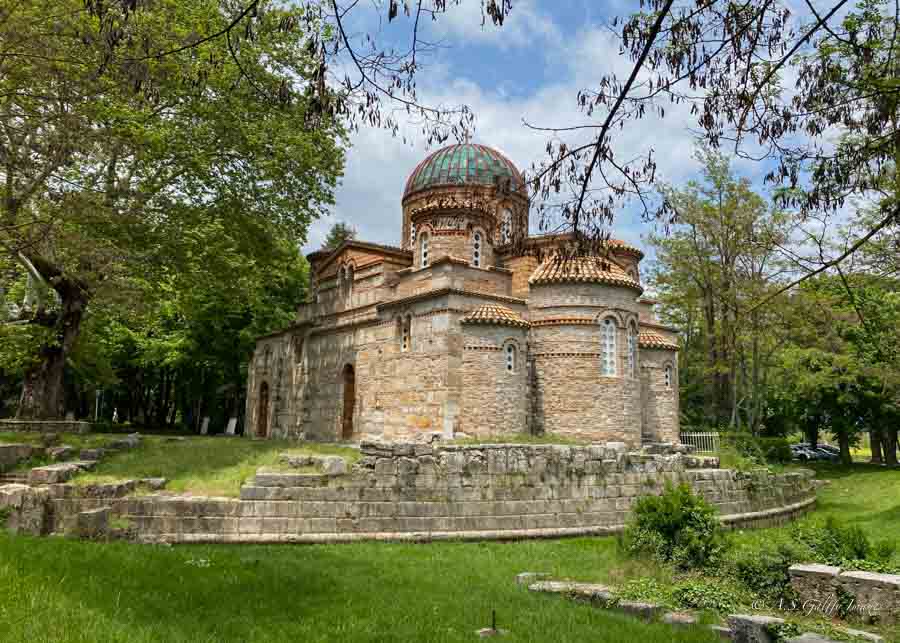
We also stopped for a wine-tasting tour at Tselepos Winery, famous for their sparkling wine of light lemon-green color and delicate aromas of citrus flowers.
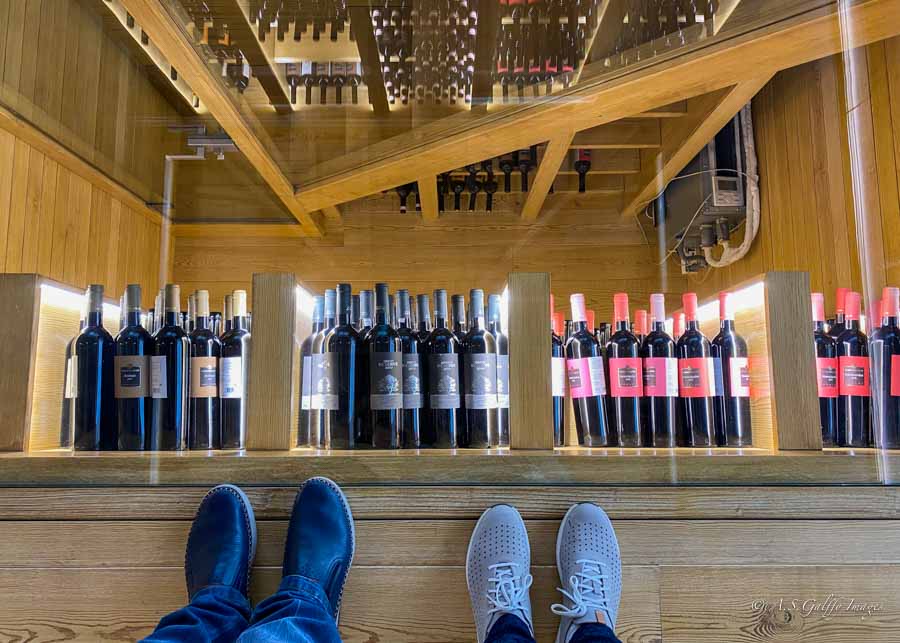
Mantinea
One of the places you shouldn’t miss when visiting Arcadia is the unusual Greek Orthodox Church of Agia Fotini, in Mantinea.
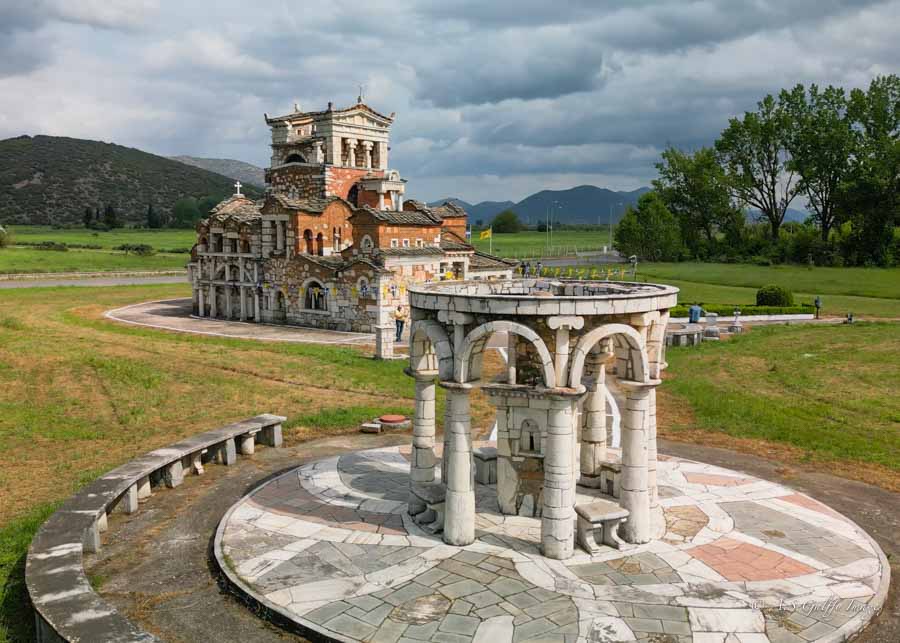
This is a very strange looking church, kind of a hodge-podge of styles. However, we found very interesting and unique, unlike any other Christian churches we’ve ever seen. There are beautiful pebble mosaics on the floor and red-brick walls and ceilings.
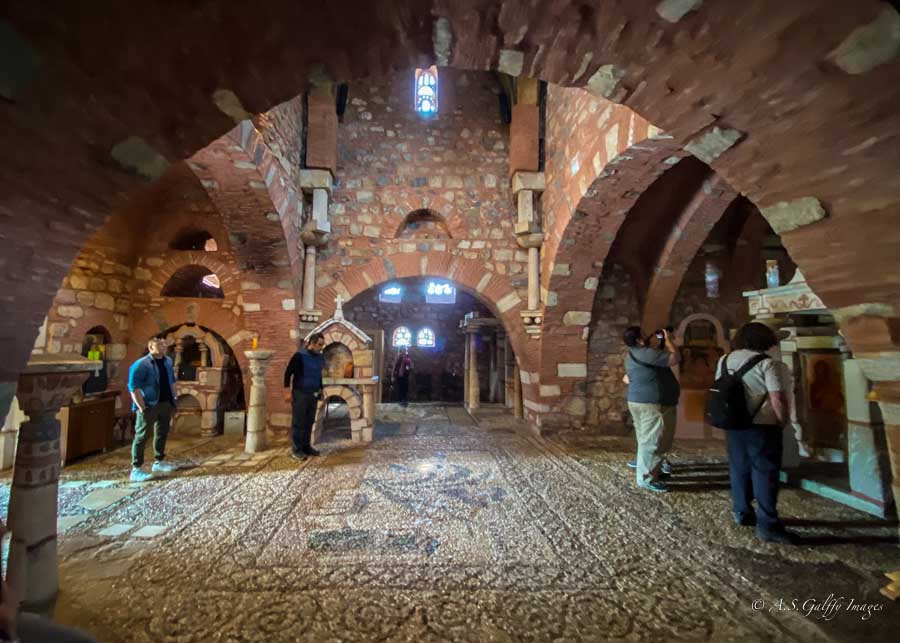
Right across from the church is the archeological site of Mantinea which is not very big, but it’s worth seeing if you are there already.
Tegea and Mantinea are only an hour away from Kalamata, you can easily visit them on a day trip. But if you decide to stay here overnight, a good place to stop is in Tripoli, the first capital of Greece and the current capital of the Peloponnese region. The area around Tripoli is so stunning that it has been nicknamed “The Switzerland of Greece.”
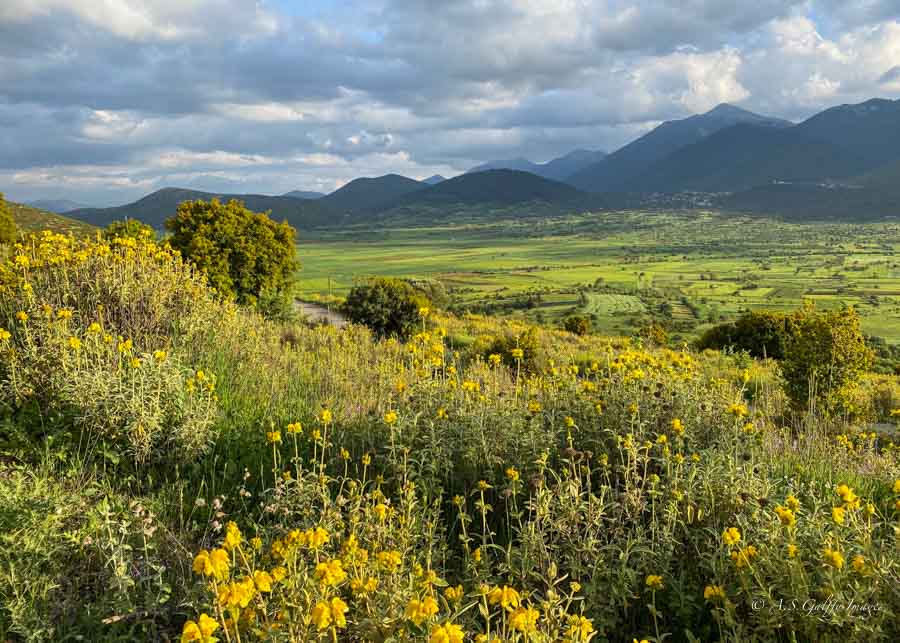
For dinner we recommend Villa Incognito, an awesome restaurant in Tripoli’s old town. You absolutely need to visit this restaurant if you appreciate fine dishes and awesome greek wine!
Day 13 Itinerary – Astros & Ano Doliana
Astros
Astros is another beautiful beach town in the Peloponnese with friendly and hospitable locals, clean, calm waters and a nice Greek village atmosphere. Located just a 25-minute drive from Nafplio, Astros has a lovely harbor, several tavernas, a few shops and beautiful beach for sunbathing.
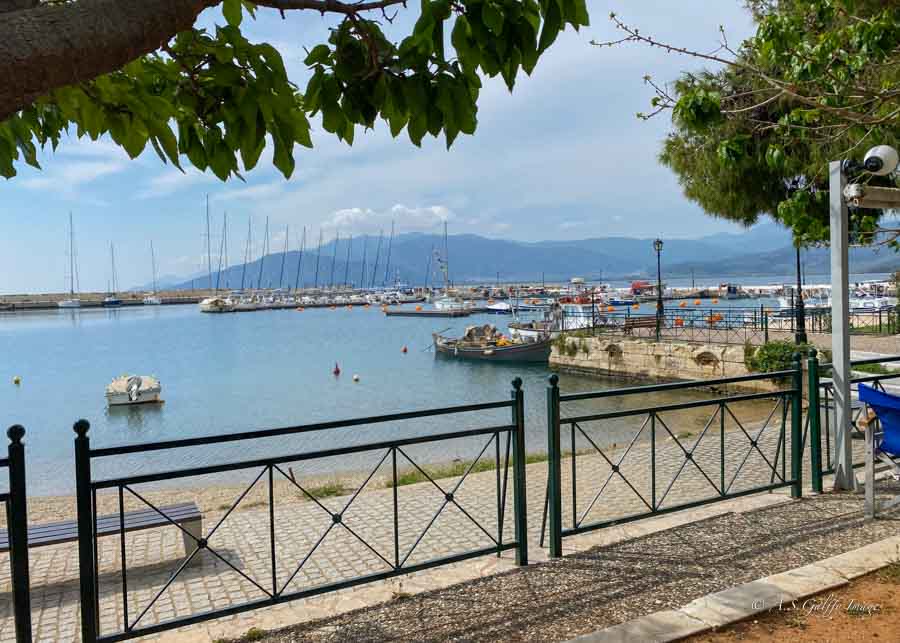
Up on the adjacent hill, you can hike to the ruins of Paralio Astros Castle from where you get beautiful views of the town below and the entire gulf.
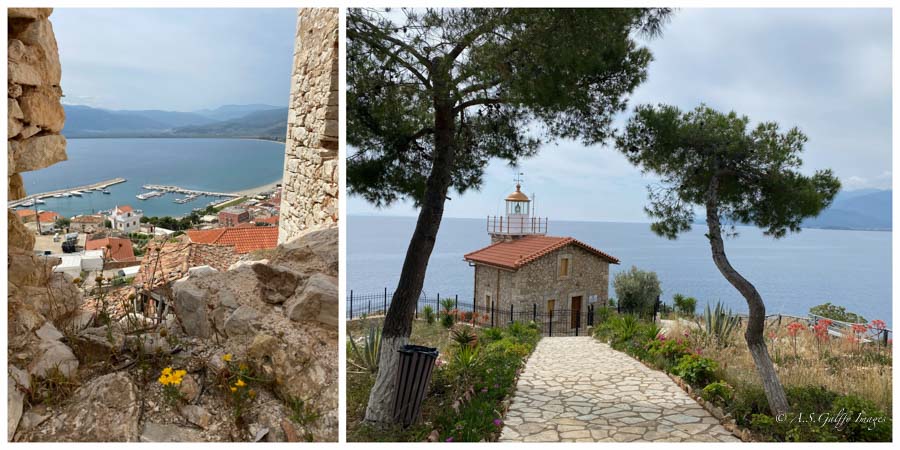
It was pretty quiet in May when we were there, but would imagine gets pretty busy in high season. Would be a good base to stay and explore the area.
Monastery of Loukou
Another interesting place we visited on this road trip was the historic Monastery of Loukou, one of the most picturesque in the Peloponnese.
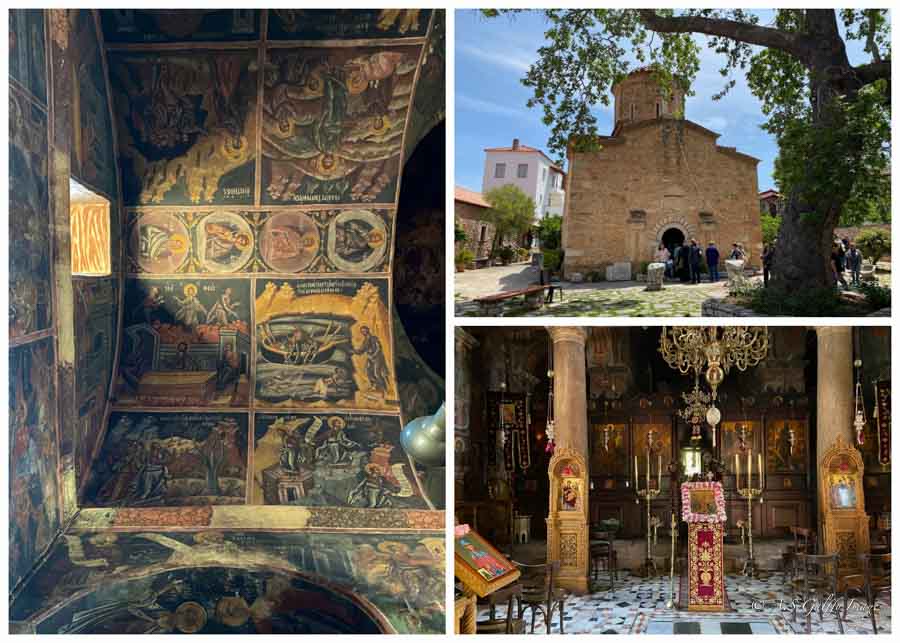
The monastery is famous for its marvelous 16th century frescos, but also for its scenic location on a spot surrounded by woods and olive groves. Close to the monastery are also the remains of a Roman villa that belonged to the Roman senator Tiberius Claudius.
Ano Doliana
One of the lesser know destinations in the Peloponnese is the lovely mountain village of Ano Doliana. The village, which was entirely built out of stone, sits at an altitude of 1000 meters (3280 feet.
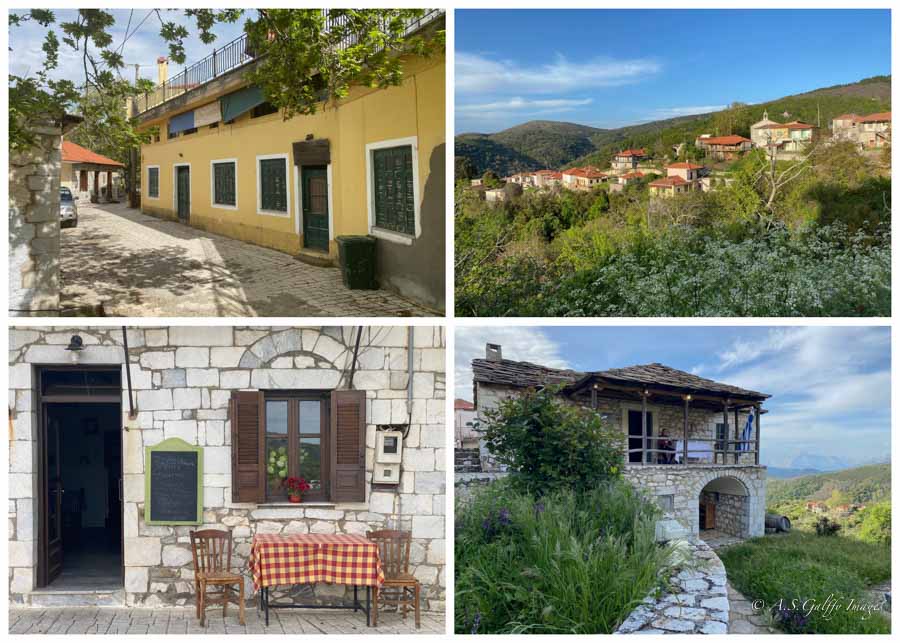
In the old times, Ano Doliana was primarily inhabited by shepherds who pastored their herds around the open areas of the land. Nowadays only a handful of people reside in the village full time. Most of the residents come here only in summer and for the rest of the year move down in Kato Doliana, which enjoys a milder climate.
In 1821, during the Greek War of Independence, Ano Doliana was the scene of the Battle of Doliana. To this day, the villagers still celebrate every year the victory of the Greek revolutionaries against the Ottomans at the Battle of Doliana.
If you visit Ano Doliana don’t miss the small Historical and Ethnographical Museum which has a beautiful collection of artifacts. There are also a few nice nice churches in town, an ancient marble quarry, and a beautiful old school/turned hotel (En Dolianis Hotel), where we stayed for one night.
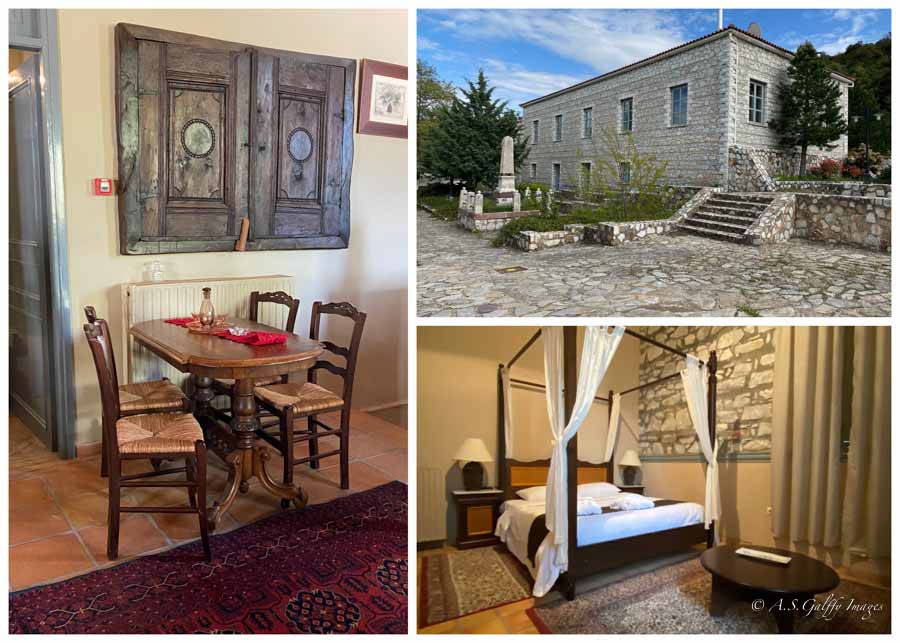
Day 14 Itinerary – Return to Athens
Our road trip in the Peloponnese ended in Athens, so on our 14th day we drove from Ano Doliana to the airport. The drive is only 2.5-3 hours long, but since this was the day of our departure we weren’t in the mood for more explorations. We planned a 2 week long and extensive itinerary that covered many wonderful sites in Greece’s mainland and the Peloponnese.
Tours We Recommend in Greece
